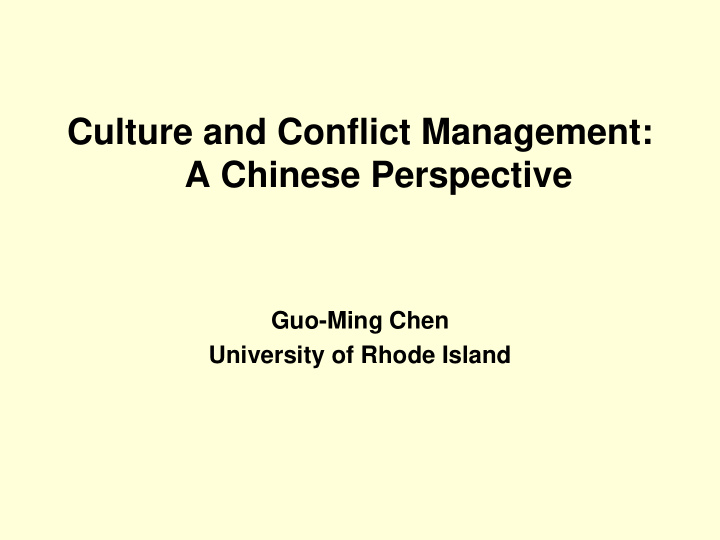



Culture and Conflict Management: A Chinese Perspective Guo-Ming Chen University of Rhode Island
Five Parts I. Introduction II. Communication is Contextually Dependent III. Paradigmatic Assumptions of Chinese Behaviors IV. Key Concepts in Understanding Chinese Behaviors V. Conclusion
I. Introduction • Cultural awareness in globalizing society - The lack of cultural awareness and proper ways to address cultural differences will result in unrealistic expectations, frustrations, conflicts, and failure in establishing a positive intercultural relationship among people from different cultures. • Rising of China - To understand the way Chinese think and act, especially how they manage and resolve conflicts, becomes an important step in maintaining a stable and peaceful world. • Purpose of this presentation - to examine the issue of conflict management and resolution from Chinese cultural perspective. Three parts: (1) I’ll argue that communication is contextually dependent and therefore an emic approach should be taken for better understanding a cultural group, (2) paradigmatic assumptions are used to demonstrate the differences between East and West, and (3) key concepts based on Chinese cultural values are illustrated for better understanding Chinese in the process of conflict management.
II. Communication is Contextually Dependent • Communication is contextually dependent and therefore an emic approach should be taken for better understanding a cultural group . • Example: Chen, Chen, & Ryan (2000). • Reflected in paradigmatic assumptions of each culture.
Table 1. National Differences on the Six Factors Table 2. Elements That Affect Conflict Managemen t Americans Chinese American Chinese (N = 50) (48) -------------------------------------------------------------------------------- ----------------------------------------------------------- 1. Time Constraint 1. My Authority Factors Mean Mean 2. Don't Care the Project 2. I'm Right (SD) (SD) 3. Grade on the Line 3. Affect Group Interest ----------------------------------------------------------- Severity *6.22 5.56 4. Poor Performance 4. Grade on the Line (.99) (.83) 5. Lack of Cooperation 5. Lack of Cooperation Credibility 5.28 5.02 (1.34) (1.65) 6. Negative Attitude 6. Poor Performance Relation 5.12 5.19 7. Laziness 7. Don't Care the Project (1.46) (1.57) 8. Refuse to Re-do 8. Time Constraint Power 4.14 4.40 (1.82) (1.69) 9. Frustrated/Angry 9. Lose My Face Seniority *3.76 4.52 10. Members Don't Help 10. Negative Attitude (1.59) (1.84) Face *3.44 4.23 11. Affect Group Interest 11. Members Don't Help (1.73) (1.80) 12. My Authority 12. Not Trustworthy ---------------------------------------------------------- -------------------------------------------------------------------------------- Note. * p < .05.
Figure 1. The distribution of mean scores of the 20 factors • The top five mean scores of the 20 factors are: (1) Relation (5.0) (2) Face (4.91) (3) Harmony (4.77) (4) Reciprocity (4.68) (5) Credibility (4.45) • Chen, G. M., & Chen, V. (2002). An examination of PRC business negotiations. Communication Research Reports, 19 , 399-408.
III. Paradigmatic Assumptions of East and West Ontology East West Holistic Atomistic submerged discrete collectivistic individualistic Axiology Epistemology Methodology East West East West East West Harmonious Confrontational Interconnected Reductionistic Intuitive Logical indirect direct reciprocity independent subjective objective subtle expressive we I nonlinear linear adaptative dialectical hierarchical equal ambiguous analytical consensual divisive associative free will ritual justificatory agreeable sermonic ascribed achieved accommodative manipulative
* Contextual Dependence of Communication Axiology (The ultimate goal of human communication) East West Harmonious Confrontational indirect direct subtle expressive adaptative dialectical consensual divisive agreeable sermonic
• The most eminent influence of Chinese belief on establishing a harmonious relationship in human communication is the effort to avoid being involved in a conflict. In order to pursue a conflict free interaction, Chinese have developed five communication rules: (1) Self-restraint/self-discipline – avoid aggressive behaviors. (2) Indirect expression of disapproval – implicit, evasive, intermediary. (3) Saving or making face for counterparts – Spy plane incident in Hainan Island in 2001 (face vs. fact). (4) Reciprocity – li shang wang lai – xiann li hou bing (5) Emphasis on particularistic relationships – guanxi *Chen, G. M. (2002). The impact of harmony on Chinese conflict management. In G. M. Chen & R. Ma (Eds.), Chinese conflict management and resolution (pp. 3-19). Westport, CT: Ablex.
* Emic View of Asian Behaviors Chinese Japanese Korean Pilipino Thai bao amae uye-ri kapwa kreng jai (reciprocity) (message expanding and (complementary and (reciprocal being) (being extremely message accepting needs) obligatory reciprocity) considerate) guanxi en pahiwatig (interrelation) (predestined relation) (strategic ambiguity) pakiramdam ke qi enryo-sasshi (politeness) (restraint-guessing) (the capacity to feel for another) miantz omoiyari (face) (altruistic sensitivity) yuan (predestined relation)
IV. Key Concept in Understanding Chinese Communication • Harmony as the Foundation of Chinese Communication • Face : Dynamism in Confucian Society • Social Relations ( Guanxi ): A Chinese Approach to Interpersonal Communication • Favor ( Renqing ): Characteristics and Practice from a Resourced-Based Perspective • Reciprocity ( Bao ): The Balancing Mechanism of Chinese Communication • Politeness ( Keqi ): The Fragrance of Chinese Communication • Rites ( Li ): The Symbolic Making of Chinese Humanity • Predestined Relation ( Yuan ): The Passionate and the Helpless of Chinese Communication • Hierarchy ( Dengji ): A Pyramid of Interconnected Relationships • Chi ( Qi ) Process: The Interplay of Opposites in Selected Communication Contexts • Divination/Fortune Telling ( Zhan Bu/Xianming ): Chinese Cultural Praxis and Worldview
V. Conclusion • The two faces of Chinese communication • Dynamics of cultural values (Chen & Chung) • Strategy ( Ji ) (Chinese compliance-gaining strategies) (Chen & Zhong)
* Factors of Chinese Compliance-Gaining Strategies (1) Delusion (2) Burrowing/Misleading (3) Distraction (4) Indirect Exploration (5) Espionage (6) Adapting (7) Deceiving * Chen, G. M., & Zhong, M. (2000). Dimensions of Chinese compliance-gaining strategies . Human Communication, 3 , 97-109.
Thank You ﹗
Recommend
More recommend